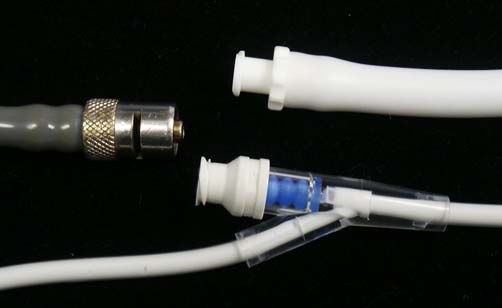Blood Pressure Monitor Tubing May Connect to IV Ports
A hospitalized patient who was connected to a portable blood pressure (BP) monitoring device was transported to radiology for an MRI. A length of tubing that led from the monitor’s BP cuff inflator had a male Luer connector. This fit into a female connector on a shorter length of white tubing that was integrated with a Critikon disposable BP cuff. See Figure 1.

The tubing and cuff were disconnected before the MRI since the Luer connector on the monitor’s tubing was metal. After the test, a radiology employee reconnected the tubing and transported the patient back to his room. Upon arrival, a family member immediately noticed that the tubing from the monitor was attached incorrectly to a needleless Y-injection port on the patient’s IV line! A nurse was contacted and she quickly disconnected the tubing. Normally, the device cycles at preset intervals, inflating the cuff with more than 500 mL of air at pressures up to 300 mm Hg. If no resistance is met with an inflated cuff, two additional cycles quickly occur. Thus, more than 1,500 mL of air might have entered the patient’s vascular system. Fortunately, this did not happen, as the machine had not yet cycled to take a BP reading. Another patient was not as lucky. In that case, the patient died from an air embolism after a nurse mistakenly connected the monitor tubing to his IV line.
Poor lighting did not contribute to either mistake, but another reported case (Stone BA. Avoid Luer connectors on BP cuffs. Anesthesiology 2002; 97:765-766) shows how similar-appearing tubing could play a role. A nurse accidentally connected BP monitor tubing to a white needleless IV port. Propofol, which is white and opaque, had been infusing through the patient’s IV line. Thus, the IV tubing and port with propofol looked very similar to the white length of tubing and connector on the BP cuff. See Figure 1. Patient tampering also could lead to a problem. In one case reported to FDA, an agitated patient died when he removed the tubing from his BP cuff and attached it to his IV line. These inadvertent connections are more likely to occur at the Y-site of needleless IV tubing since it requires no manipulation of the tubing. But it is also possible to connect monitor tubing to any other tubing with a Luer connector.
FDA and manufacturers have been aware for some time that Luer connections are used sometimes to connect monitors to disposable BP cuffs, and that patient deaths have occurred with inadvertent connections to IV systems. Because of the risk of air embolism, manufacturers previously issued warning letters (Spacelabs Medical Urgent Product Safety Alert, October 29, 2001), and many biomedical engineering departments alerted clinical managers to the problem. Some manufacturers also provide warning labels for the monitors and tubing. Others plan to require dedicated tubing with non-Luer connectors. However, as long as disposable BP cuffs are available with female Luer connectors, tubing from the monitor can be inadvertently connected to an IV.
Although it might be a rare occurrence, this hazard exists at many hospitals. Indeed, newer monitors may have a proprietary non-Luer connection at the monitor end, but either the proprietary connector or a Luer connector can be used with the BP cuff. Some hospitals that have monitors from different manufacturers may use cuffs with Luer connectors and replace proprietary monitor tubing to make all connections compatible. Just last week, a hospital provided ISMP with BP monitor tubing with a male Luer connector, and a disposable cuff with a female Luer connector, both without warning labels. In follow-up with several other hospitals, we also learned that most clinical staff were unaware of the problem, even though their patients were exposed to this hazard.
ISMP has contacted FDA’s Center for Devices and Radiological Health, ECRI, and several manufacturers. All agree that requiring non-Luer connections will best solve this problem. Until this becomes a standard, develop a plan to replace all BP monitoring equipment to ensure incompatibility with Luer connections. Meanwhile, to protect patients, place BP cuffs on a different arm than the IV site, and remove IV catheters as soon as they are no longer needed. Labels on equipment and staff awareness may be helpful, but unlikely to have a sustained effect.
Suggested citation:
Institute for Safe Medication Practices (ISMP). Blood pressure monitor tubing may connect to IV ports. ISMP Medication Safety Alert! Acute Care. 2003;8(12):1-2.
Access this Free Resource
You must be logged in to view and download this document.
